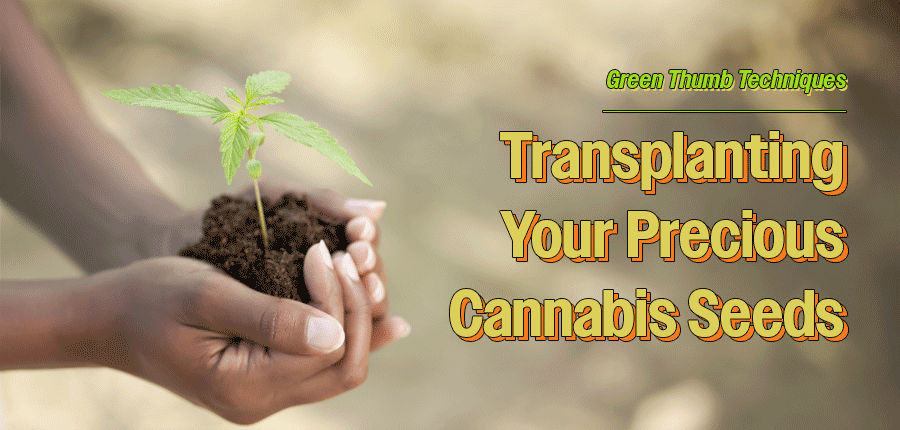The cultivation of cannabis has witnessed a significant surge due to the increasing demand for recreational and medical purposes. This rise in demand has led to a higher need for transferring cannabis seeds, involving the relocation of plants and fresh soil between containers. It is crucial to comprehend the importance and advantages of transplanting cannabis seedlings as it plays a vital role in promoting robust and thriving plant growth.
To unlock their full potential, cannabis seedlings necessitate transplantation to foster growth and development. These young plants require specific conditions that can effectively support establishing their root systems. Adhering to a timely transplanting schedule gives the seedlings sufficient space and nutrients for their growth. Through this process, the growth of cannabis plants can be significantly enhanced, as it mitigates the adverse effects of overcrowding and resource competition. Furthermore, transferring the seedlings to larger containers enables their roots to stretch, thereby improving soil water absorption and nutrient uptake. Consequently, the overall health and vitality of the plants are greatly enhanced.
Before Transplanting Cannabis Seeds
Successful transplantation and healthy growth of cannabis seedlings require adherence to important steps. The first step is carefully selecting containers that are the right size and made from suitable materials. These containers should provide ample space for the seedlings to grow and ensure proper drainage to prevent waterlogging, which can harm the plants. It is also crucial that the containers allow for breathability and sufficient airflow to prevent root rot.
The next step is to prepare the soil or growing medium before transplanting. Choose a nutrient-rich soil or medium with good drainage properties. Maintaining the pH levels of the soil between 6.0 and 7.0 is recommended for optimal nutrient absorption. Consider adding compost, perlite, or vermiculite to enrich the nutrient content of the soil.
Timing is a crucial factor in transplanting cannabis seedlings. Select seedlings with strong roots and two to three sets of leaves for transplantation. Carefully time the process to avoid stunted growth and ensure the plants can thrive.
Before transplanting, provide pre-transplantation care to the seedlings. This includes proper watering and feeding to maintain their health. It is essential to maintain appropriate moisture levels to establish robust roots, but be cautious not to overwater, as it can result in waterlogging and root rot. Regularly monitor and adjust watering practices to maintain optimal soil moisture. Additionally, use a balanced fertilizer to promote healthy growth and development of the seedlings.
By following these steps and providing diligent care throughout the transplantation process, you can create favorable conditions for the successful growth and development of your cannabis seedlings.
During Transplanting Cannabis Seeds
To ensure successful transplantation and healthy growth of cannabis seedlings, it is important to follow the following steps:
1. Ensure that the growing medium is rich in nutrients and has good drainage properties.
2. Prepare the container by adding soil, leaving sufficient space for the seedling’s root ball.
3. Create a big hole in the center of the soil, ensuring it can accommodate the delicate root ball without causing any damage.
4. Carefully remove the seedling from its previous container, keeping the roots intact and undamaged.
5. Gently place the seedling into the prepared hole, ensuring the surrounding soil adequately covers the root ball.
6. Water the seedling cautiously, avoiding excessive saturation. The soil should be moist but not overly soaked.
7. Position the container in a suitable location with ample light and provide the necessary nutrients to support vigorous growth.
8. Monitor the seedling closely during its initial days in the new environment, paying attention to signs of stress such as wilting. Adjust watering and nutrient levels as needed.
By following these steps, you can ensure a smooth transplantation process and provide the ideal conditions for the healthy development of your cannabis seedlings.
After Transplanting Cannabis Seeds
When encountering common problems with cannabis seedlings after transplantation, there are several ways to address and handle these issues effectively.
To minimize the impact of transplant shock, employing various strategies is beneficial. These include creating a stable environment, temporarily adjusting water and nutrient intake, reducing physical disturbances, preventing waterlogging, addressing underwatering and nutrient deficiencies, and promptly resolving any identified issues.
One effective approach is to relocate the seedlings to a shaded area. This reduces their exposure to direct sunlight, creating a stress-free environment that aids adaptation and minimizes transplant shock.
To alleviate plant stress, reducing the amount of water and nutrients provided temporarily is advisable. This gradual adjustment allows the seedlings to acclimate to their new surroundings without overwhelming their delicate systems.
During the critical transition period, handling the seedlings gently and avoiding unnecessary physical disturbances is important. Minimizing movement and disturbances helps prevent additional stress on the plants.
To prevent waterlogging, avoid overwatering the seedlings. Reduce the watering frequency and allow the soil to dry out between waterings partially. Ensuring proper container drainage by using well-draining soil and containers with drainage holes is crucial. Promoting good airflow around the seedlings can further prevent excessive moisture buildup and reduce the risk of waterlogging.
If signs of underwatering are observed, increase the frequency of watering to address the issue. Maintaining adequate soil moisture is essential for healthy growth. Incorporating mulch or moisture-retaining substances into the soil helps maintain proper hydration and prevents rapid evaporation.
Addressing nutrient deficiencies is vital for the well-being of the seedlings. Supplement them with necessary nutrients using fertilizers or organic amendments. Adjusting the soil’s pH level within the optimal range of 6.0-7.0 enhances nutrient uptake and helps resolve potential deficiencies.
Regularly monitor the growth of the seedlings for signs of stress, nutrient deficiencies, or pest infestations. Stay adaptable to environmental factors and make necessary adjustments, such as modifying lighting, temperature, and humidity levels, to create an optimal growing environment. Promptly address any problems or issues that arise, taking appropriate measures to mitigate the identified issues and provide the necessary care for the healthy development of the seedlings following transplantation.

